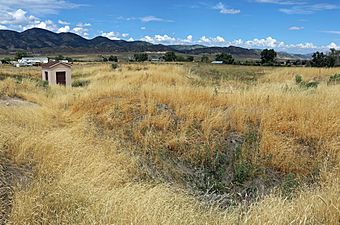Lamb Spring facts for kids
Lamb Spring is a really old archaeological site in Douglas County, Colorado. It's famous for having the biggest collection of Columbian mammoth bones in Colorado! This special place also shows that early people, called Paleo-Indians, hunted here much later. Lamb Spring was added to the National Register of Historic Places in 1997 because of its importance.
Contents
Discovering Lamb Spring's Secrets
Who Were the Paleo-Indians?
The Paleo-Indians were some of the first people to live in North America. They mostly hunted huge animals called megafauna. Imagine giant bison and mammoths! This was during a time when the Ice Age was ending.
As the weather got warmer, melting glaciers created lakes and grassy plains. But then, the land became drier. There wasn't enough food for the huge animals, and many of them died out. The Paleo-Indians had to change their ways. They started hunting smaller animals and gathering wild plants to eat.
Lamb Spring was a very important site for these early people. Scientists have found bones from Megafauna like ancient bison, camels, mammoths, and horses here.
Mammoths and Early Humans
Some of the mammoth bones at Lamb Spring might be even older than the earliest known human culture in North America, called the Clovis tradition. The Clovis people lived about 11,200 years ago. But some mammoth bones at Lamb Spring are dated to be around 11,735 to 13,140 years old!
Many of the large bones found here look like they were broken. This might mean that early humans were butchering the animals for food. Some broken rocks were also found with the bones. Scientists are still trying to figure out if these rocks were used as tools. It's not yet fully proven that Lamb Spring is a "pre-Clovis" site, meaning humans were here before the Clovis people. But future digs might find more tools and stronger proof!
Bones from ancient camels and tools found at the site date back to about 11,000 BC. Lamb Spring has the largest collection of Columbian mammoth bones in Colorado. Scientists also found bones from antelope and small rodents. After 11,000 BC, the climate changed a lot. All the megafauna, except for the ancient bison, disappeared. Around 7000 or 6500 BC, Paleo-Indians were still hunting bison and smaller animals at the spring.
How Lamb Spring Was Found
In the summer of 1960, a man named Charles Lamb was building a pond on his property. He was digging near a natural spring when he found something amazing: mammoth tusks and bones! These bones were about 13,000 years old. He also found bones from bison, camels, and horses.
His discovery quickly led to many archaeological teams coming to investigate the site.
What Archaeologists Found
Many different groups of scientists have studied Lamb Spring over the years. Here's a quick look at some of their cool discoveries:
- In 1960, Dr. G. Edward Lewis from the United States Geological Survey confirmed that the tusks and bones were from the Pleistocene period. This is a very old time in Earth's history.
- Later that year, Dr. Lewis and Dr. Glenn Scott found bones from many different animals. They also found small flint chips at the same depth as the mammoth bones. This suggested that Paleo-Indians might have hunted the mammoths.
- From 1961 to 1962, Dr. Waldo Wedel and Dr. C.L. Gazin from the Smithsonian Institution found bones from five mammoths. These bones were a little older than 13,000 years, from the end of the Ice Age. They also found eight different layers of soil, showing different time periods.
- In a deeper layer, dated around 6870 BC, they found special spear points and knives from the Cody complex culture. They also found bison bones and tools for cutting and scraping hides.
- From 1980 to 1981, Dr. Dennis Stanford from the Smithsonian Institution found bones from 30 mammoths! He also found more proof that these mammoths had been hunted. These bones were dated to be between 10,140 and 12,140 BC. More bison bones and Cody tools were found in a newer layer of soil.
- In 2002, Dr. James Dixon and Dr. Paul Murphy from the University of Colorado-Boulder and the Denver Museum of Nature and Science dug up a Columbian mammoth skull. It was probably from a young mammoth and was about 11,000 BC old.
You can see some of the amazing artifacts from Lamb Spring at the Denver Museum of Nature and Science and the National Museum of Natural History in Washington, D.C..
Visiting the Lamb Spring Archaeological Preserve
The land around the Lamb Spring site, about 32 acres, was bought by The Archaeological Conservancy in 1995. They worked with the Denver Museum of Nature and Science, Douglas County, Colorado, and the Smithsonian Institution to protect this important place.
You can visit Lamb Spring for free tours! They happen from May through October, on the first Saturday of each month. These tours are a great way to learn more about the ancient history hidden in the ground.


